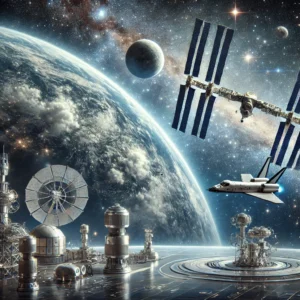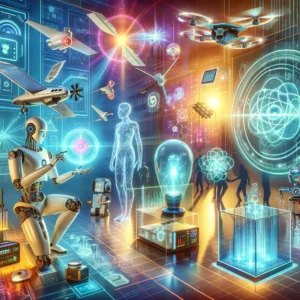The Future of Space Exploration: Technology on the Horizon

The Future of Space Exploration: Technology on the Horizon.
Explore the future of space exploration with groundbreaking technologies shaping interplanetary travel, AI-driven missions, and sustainable space practices. Discover what lies on the horizon.
Space exploration has always fascinated humanity, sparking innovation and pushing the boundaries of science and technology. As we stand on the brink of a new era in space exploration, emerging technologies are set to transform how we study, explore, and inhabit the cosmos. This article explores the cutting-edge advancements poised to shape the future of space exploration.
—
1. The Next Generation of Spacecraft
Revolutionary Propulsion Systems
One of the biggest challenges in space exploration is the distance between celestial bodies. Advanced propulsion systems like ion thrusters and nuclear thermal propulsion are set to revolutionize space travel. These technologies promise faster travel times and greater fuel efficiency, making interplanetary missions more feasible.
Reusable Spacecraft
Companies like SpaceX and Blue Origin have already demonstrated the potential of reusable rockets. Future spacecraft will not only be reusable but also equipped with smart systems for self-repair and efficient navigation, significantly reducing costs and increasing mission reliability.
—
2. Artificial Intelligence and Robotics
Autonomous Rovers and Probes
Robotic explorers have become the backbone of interplanetary exploration. Future missions will feature autonomous rovers capable of making decisions in real-time, navigating complex terrains, and conducting scientific experiments without direct human intervention.
AI in Data Analysis
Artificial Intelligence (AI) is set to play a pivotal role in processing vast amounts of data collected during space missions. From identifying potential landing sites to analyzing atmospheric conditions, AI will help scientists make informed decisions faster.
READ ALSO: Top 5 Open-Source Tools for Data Analytics in 2024.
—
3. The Role of Space Stations
Lunar and Martian Outposts
The construction of permanent bases on the Moon and Mars is no longer a distant dream. These outposts will serve as hubs for research, resource extraction, and launching pads for deeper space exploration.
Orbiting Habitats
Orbiting space stations like the International Space Station (ISS) are precursors to larger, more advanced habitats. Future stations will feature artificial gravity, sustainable life-support systems, and advanced communication networks, making long-term space habitation possible.
—
4. Advancements in Space Telescopes
The James Webb Space Telescope has already provided glimpses into the universe’s earliest moments. Future telescopes, such as the Nancy Grace Roman Space Telescope, will delve deeper into dark energy, exoplanet exploration, and the search for extraterrestrial life.
Spectroscopy and Imaging
Advancements in spectroscopy and imaging technologies will allow scientists to study the chemical composition of distant planets’ atmospheres, providing clues about their habitability.
—
5. Space Mining and Resource Utilization
Asteroid Mining
Asteroids are rich in rare metals and other valuable resources. Technologies for mining these celestial bodies are in development, potentially unlocking a trillion-dollar space economy.
In-Situ Resource Utilization (ISRU)
ISRU involves using local resources, such as Martian water and lunar regolith, to produce fuel, oxygen, and construction materials. This technology is critical for sustainable exploration and colonization efforts.
—
6. Human Spaceflight
Deep Space Missions
The Artemis program aims to return humans to the Moon, but the ultimate goal is Mars. Advanced life-support systems, radiation shielding, and crewed spacecraft like SpaceX’s Starship will make these missions possible.
Space Tourism
As space becomes more accessible, space tourism is set to become a thriving industry. Companies are already developing spacecraft designed specifically for commercial use, offering unique opportunities for private individuals to experience space.
—
7. The Search for Extraterrestrial Life
The discovery of microbial life on Mars or Europa could redefine our understanding of life in the universe. Missions like Europa Clipper and Perseverance are equipped with tools to detect biosignatures, and future missions will focus on more advanced life-detection technologies.
—
8. Sustainability in Space
Debris Management
The growing problem of space debris poses a significant threat to future missions. New technologies, such as satellite recycling and debris capture systems, aim to mitigate this issue.
Green Propulsion
Eco-friendly propulsion systems are being developed to minimize the environmental impact of space exploration.
—
9. International Collaboration
Space exploration is increasingly becoming a global effort. Initiatives like the Artemis Accords and collaborations between NASA, ESA, and other space agencies emphasize the importance of international cooperation in achieving ambitious space goals.
—
Conclusion
The future of space exploration is brimming with possibilities, driven by technological innovation and global collaboration. From advanced spacecraft and AI-driven missions to sustainable practices and the search for extraterrestrial life, humanity is on the cusp of an exciting new chapter in its cosmic journey.





